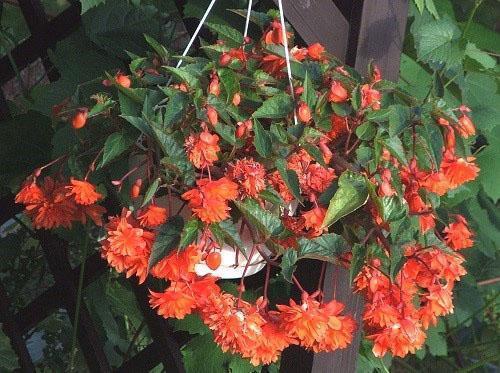Growing ampelous begonia
 A distinctive feature of the ampelous begonia is the shape of the bush. It has drooping shoots and is intended for growing in pots and other hanging pots. Accordingly, this variety has its own cultivation characteristics, which experienced florists willingly share.
A distinctive feature of the ampelous begonia is the shape of the bush. It has drooping shoots and is intended for growing in pots and other hanging pots. Accordingly, this variety has its own cultivation characteristics, which experienced florists willingly share.
First of all, when buying tubers in a store, you must carefully read the name on the package, so that instead of an ampelous curly beauty you do not get an erect begonia. Of course, it is also very beautiful, but when planted in a hanging pot, tall, straight shoots will quickly break in the wind.
Preplanting tuber
All purchased tubers should be pickled before planting in the ground in order to disinfect and stimulate growth. To do this, put the tuber for 20 minutes in a solution based on the drug Maxim-Dachnik (2 ml per 1 liter of water).
Next, the nodule can be placed on moist soil or simply left in a plastic container under a lid. In a warm and humid environment, the buds will quickly wake up, and then it’s time to plant the tubers.
Pot and soil preparation
For planting ampelous begonia you can use both hanging pots and high wide flowerpots with legs. The main thing is that the shoots are at some distance from the ground and have the ability to hang freely.
As for the substrate, it must also be pre-processed and prepared:
- Good for dressing soil Glyocladin drug: pour over the substrate and let stand for 30 minutes.
- Take some earth from the flowerpot and add the hydrogel. It will protect the soil from rapid drying out and moisture loss. It is not necessary to put a lot of hydrogel, it is enough to replace 1/3 of the soil, or even less. You can mix it with soil or leave it in the center of the pot.
When using a hydrogel, it is better to divide the watering rate into two parts and water it in two passes. Pour some water into a pot, wait a few minutes until the gel has absorbed the liquid, and then add a second portion.
Planting begonias
Put the processed ampel begonia tuber in moist soil, deepening "on the shoulders". You do not need to cover it with earth. Over time, when seedlings hatch and begin to actively develop, the substrate should be added as they grow.
To prevent root rot of tubers, it is recommended to add vermiculite to the pot by scattering it over the soil surface.